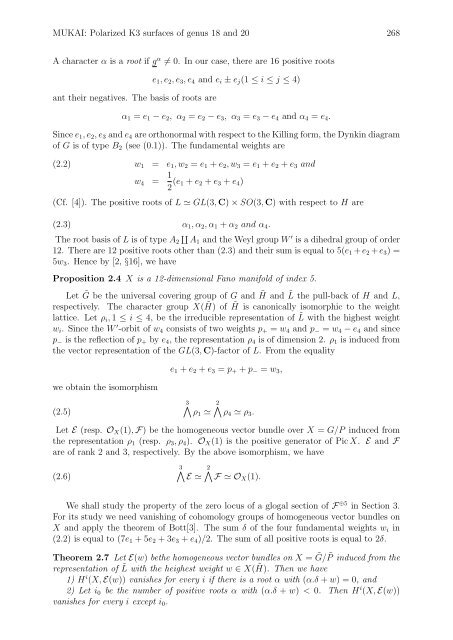Polarized K3 surfaces of genus 18 and 20 - Research Institute for ...
Polarized K3 surfaces of genus 18 and 20 - Research Institute for ...
Polarized K3 surfaces of genus 18 and 20 - Research Institute for ...
Create successful ePaper yourself
Turn your PDF publications into a flip-book with our unique Google optimized e-Paper software.
MUKAI: <strong>Polarized</strong> <strong>K3</strong> <strong>surfaces</strong> <strong>of</strong> <strong>genus</strong> <strong>18</strong> <strong>and</strong> <strong>20</strong> 268<br />
A character α is a root if g α ≠ 0. In our case, there are 16 positive roots<br />
ant their negatives. The basis <strong>of</strong> roots are<br />
e 1 , e 2 , e 3 , e 4 <strong>and</strong> e i ± e j (1 ≤ i ≤ j ≤ 4)<br />
α 1 = e 1 − e 2 , α 2 = e 2 − e 3 , α 3 = e 3 − e 4 <strong>and</strong> α 4 = e 4 .<br />
Since e 1 , e 2 , e 3 <strong>and</strong> e 4 are orthonormal with respect to the Killing <strong>for</strong>m, the Dynkin diagram<br />
<strong>of</strong> G is <strong>of</strong> type B 2 (see (0.1)). The fundamental weights are<br />
(2.2)<br />
w 1 = e 1 , w 2 = e 1 + e 2 , w 3 = e 1 + e 2 + e 3 <strong>and</strong><br />
w 4 = 1 2 (e 1 + e 2 + e 3 + e 4 )<br />
(Cf. [4]). The positive roots <strong>of</strong> L ≃ GL(3, C) × SO(3, C) with respect to H are<br />
(2.3)<br />
α 1 , α 2 , α 1 + α 2 <strong>and</strong> α 4 .<br />
The root basis <strong>of</strong> L is <strong>of</strong> type A 2<br />
∐ A1 <strong>and</strong> the Weyl group W ′ is a dihedral group <strong>of</strong> order<br />
12. There are 12 positive roots other than (2.3) <strong>and</strong> their sum is equal to 5(e 1 + e 2 + e 3 ) =<br />
5w 3 . Hence by [2, §16], we have<br />
Proposition 2.4 X is a 12-dimensional Fano manifold <strong>of</strong> index 5.<br />
Let ˜G be the universal covering group <strong>of</strong> G <strong>and</strong> ˜H <strong>and</strong> ˜L the pull-back <strong>of</strong> H <strong>and</strong> L,<br />
respectively. The character group X( ˜H) <strong>of</strong> ˜H is canonically isomorphic to the weight<br />
lattice. Let ρ i , 1 ≤ i ≤ 4, be the irreducible representation <strong>of</strong> ˜L with the highest weight<br />
w i . Since the W ′ -orbit <strong>of</strong> w 4 consists <strong>of</strong> two weights p + = w 4 <strong>and</strong> p − = w 4 − e 4 <strong>and</strong> since<br />
p − is the reflection <strong>of</strong> p + by e 4 , the representation ρ 4 is <strong>of</strong> dimension 2. ρ 1 is induced from<br />
the vector representation <strong>of</strong> the GL(3, C)-factor <strong>of</strong> L. From the equality<br />
we obtain the isomorphism<br />
e 1 + e 2 + e 3 = p + + p − = w 3 ,<br />
(2.5)<br />
3∧<br />
ρ1 ≃<br />
2∧<br />
ρ4 ≃ ρ 3 .<br />
Let E (resp. O X (1), F) be the homogeneous vector bundle over X = G/P induced from<br />
the representation ρ 1 (resp. ρ 3 , ρ 4 ). O X (1) is the positive generator <strong>of</strong> Pic X. E <strong>and</strong> F<br />
are <strong>of</strong> rank 2 <strong>and</strong> 3, respectively. By the above isomorphism, we have<br />
(2.6)<br />
3∧<br />
E ≃ 2 ∧<br />
F ≃ OX (1).<br />
We shall study the property <strong>of</strong> the zero locus <strong>of</strong> a glogal section <strong>of</strong> F ⊕5 in Section 3.<br />
For its study we need vanishing <strong>of</strong> cohomology groups <strong>of</strong> homogeneous vector bundles on<br />
X <strong>and</strong> apply the theorem <strong>of</strong> Bott[3]. The sum δ <strong>of</strong> the four fundamental weights w i in<br />
(2.2) is equal to (7e 1 + 5e 2 + 3e 3 + e 4 )/2. The sum <strong>of</strong> all positive roots is equal to 2δ.<br />
Theorem 2.7 Let E(w) bethe homogeneous vector bundles on X = ˜G/ ˜P induced from the<br />
representation <strong>of</strong> ˜L with the heighest weight w ∈ X( ˜H). Then we have<br />
1) H i (X, E(w)) vanishes <strong>for</strong> every i if there is a root α with (α.δ + w) = 0, <strong>and</strong><br />
2) Let i 0 be the number <strong>of</strong> positive roots α with (α.δ + w) < 0. Then H i (X, E(w))<br />
vanishes <strong>for</strong> every i except i 0 .
















